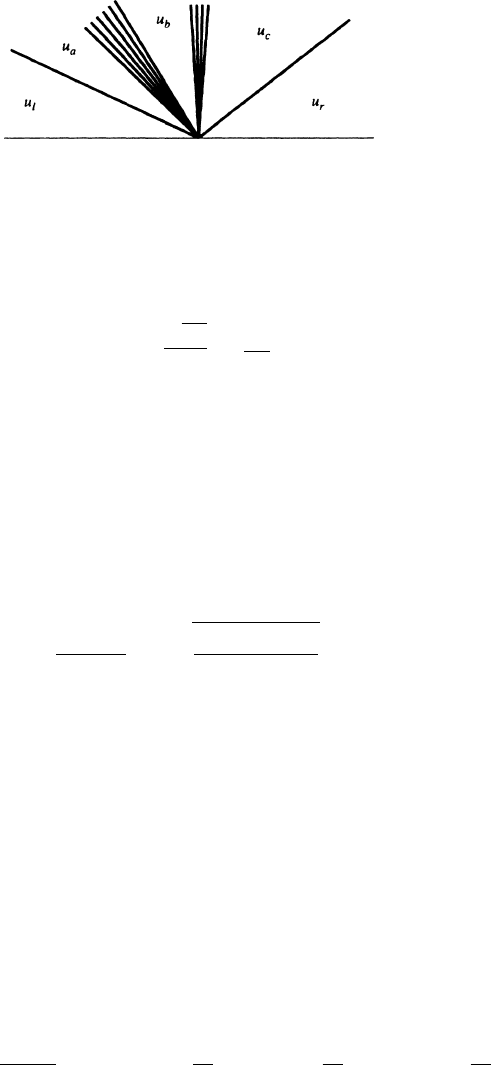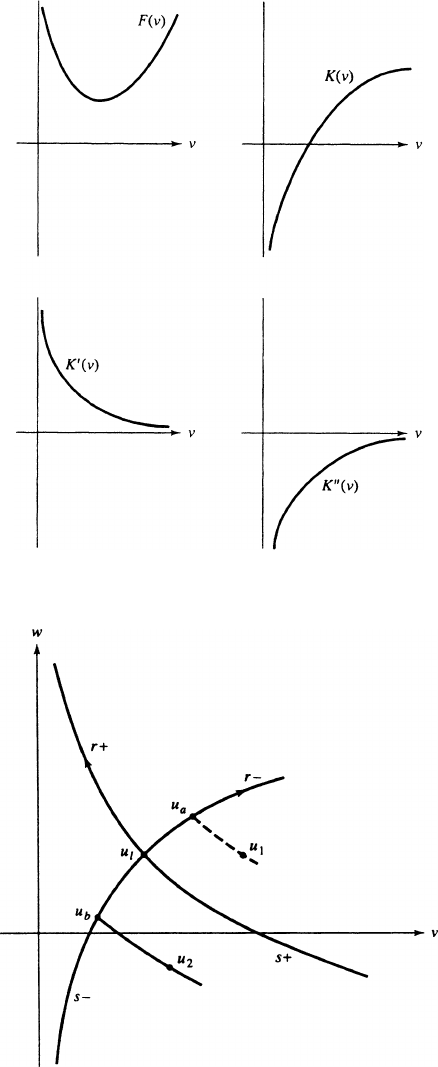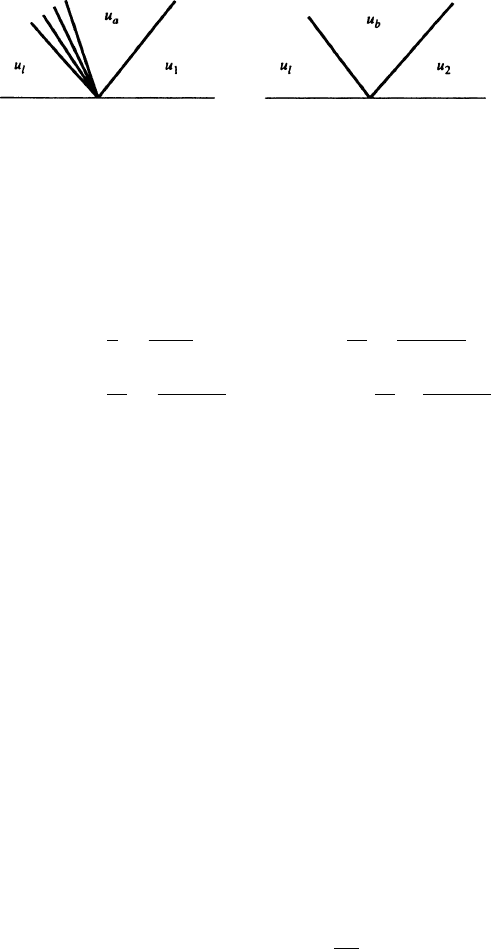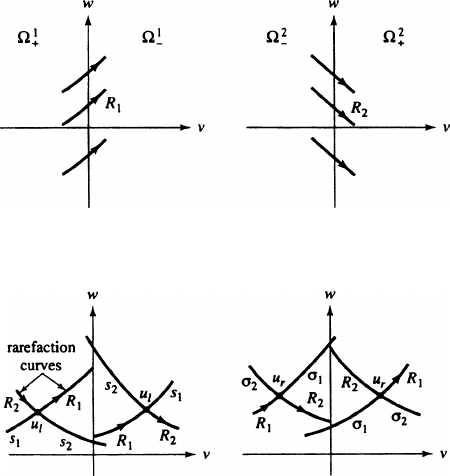Taylor M.E. Partial Differential Equations III: Nonlinear Equations
Подождите немного. Документ загружается.


478 16. Nonlinear Hyperbolic Equations
In fact, assuming genuine nonlinearity, we can arrange that '
j
.u
`
I/ be a C
2
curve, after perhaps a further reparameterization of '
s
j
.u
`
I/. To see this, we com-
pute the second -derivatives at D 0. This time, for notational simplicity, we
denote the j -shock curve by '
s
./ and the j -rarefaction curve by '
r
./.
Recall that, given (7.22), the second equation in (7.20) becomes
(7.42) '
0
r
./ D r
j
'
r
./
:
Differentiation of this plus use of (7.26) yields
(7.43) '
00
r
.0/ Dr
r
j
.u
`
/
r
j
.u
`
/:
Next, we take the -derivative of (7.33). Set A./ D A
'
s
./
.Weget
(7.44)
A./ s
j
./
'
00
s
./ C
A
0
./ s
0
j
./
'
0
s
./
D s
00
j
./
'
s
./ u
`
C s
0
j
./'
0
s
./:
Thus, since s
j
.0/ D
j
.u
`
/ and '
0
s
.0/ D r
j
.u
`
/,wehave
(7.45)
A.0/
j
.u
`
/
'
00
s
.0/ D
s
0
j
.0/ A
0
.0/
r
j
.u
`
/:
Now A./r
j
'
s
./
D
j
'
s
./
r
j
'
s
./
. Let us write this identity as
A./
j
./
r
j
./ D 0 and differentiate, to obtain
(7.46)
A.0/
j
.u
`
/
r
0
j
.0/ D
0
j
.0/ A
0
.0/
r
j
.u
`
/:
Subtracting from (7.45), we get
(7.47)
A.u
`
/
j
.u
`
/
'
00
s
.0/ r
0
j
.0/
D
2s
0
j
.0/
0
j
.0/
r
j
.u
`
/:
Now the left side of (7.47) belongs to V
j
, which is complementary to the span of
r
j
.u
`
/, so both sides of (7.47) must vanish. This implies
(7.48) s
0
j
.0/ D
1
2
0
j
.0/ D
1
2
'
0
s
.0/ r
j
.u
`
/ D
1
2
;
and, since '
00
s
.0/ r
0
j
.0/ belongs to the null space of A.u
`
/
j
.u
`
/,
(7.49) '
00
s
.0/ D r
0
j
.0/ C ˇr
j
.u
`
/;
for some ˇ 2 R.

7. Systems of conservation laws in one space variable; Riemann problems 479
Note that r
0
j
.0/ coincides with the quantity in (7.43). We claim that we can
reparameterize '
s
./ so that ˇ D 0 in (7.49), by taking
(7.50) e'
s
./ D '. C ˛
2
/;
for appropriate ˛. Indeed, we have e'
s
.0/ D '
s
.0/; e'
0
s
.0/ D '
0
s
.0/,and
(7.51) e'
00
s
.0/ D '
00
s
.0/ C 2˛'
0
s
.0/ D '
00
s
.0/ C 2˛r
j
.u
`
/:
Thus, taking ˛ Dˇ=2 in (7.50) accomplishes this goal. Replacing '
s
./ by
(7.50), we arrange that the curve '
j
.u
`
I/ is C
2
in .
Note that if u
r
D '
s
j
.u
`
I/,forsome 2 .
j
;0, the identity (7.48) together
with (7.35) implies that the shock speed s D s
j
./ of the weak solution (7.17)
satisfies
j
.u
r
/<s<
j
.u
`
/, at least if is close enough to 0.Inviewofthe
ordering of the eigenvalues of A.u/, we have the inequalities
(7.52)
j 1
.u
`
/<s<
j
.u
`
/;
j
.u
r
/<s<
j C1
.u
r
/;
for sufficiently close to 0. These are called the Lax j -shock conditions.The
corresponding weak solutions are called shock waves.
The function '
j
.u
`
I/ is in fact C
2
in .u
`
I/. We can define a C
2
-map
(7.53) ‰.u
`
I
1
;:::;
L
/ D '
L
'
L1
.'
1
.u
`
/I
1
/ /I
L1
I
L
:
Since .d=d /'
j
.u
`
I0/ D r
j
.u
`
/ and the eigenvectors r
j
.u
`
/ form a basis of R
L
,
we can use the inverse function theorem to conclude the following:
Proposition 7.1. Assume the L L system (7.1) is strictly hyperbolic and gen-
uinely nonlinear in each field. Given u
`
2 , there is a neighborhood O of u
`
such that if u
r
2 O, then there is a weak solution to (7.1) with initial data
(7.54)
u.0; x/ D u
`
; for x<0;
u
r
; for x>0;
consisting of a set of rarefaction waves and/or shock waves satisfying the Lax
conditions (7.52).
See Fig. 7.2 for an illustration, with L D 4.
We consider how Proposition 7.1 applies to some examples. First consider the
system (7.14), arising from the second-order equation (7.11). Here, with r
˙
and
˙
given by (7.16), we have
(7.55) r
˙
r
˙
D˙
1
2
K
1=2
v
K
vv
:

480 16. Nonlinear Hyperbolic Equations
FIGURE 7.2 Shocks and Rarefactions
The strict hyperbolicity assumption is K
v
¤ 0 on . Given this, the hypothesis
of genuine nonlinearity is that K
vv
is nowhere vanishing. To achieve (7.22), we
would rescale r
˙
, changing it to
(7.56) r
˙
D2
p
K
v
K
vv
1
p
K
v
:
In this case, given u
`
D .v
`
;w
`
/ 2 R
2
, the rarefaction curves emanating
from u
`
are the forward orbits of the vector fields r
C
and r
, starting at u
`
.The
jump condition (7.29) takes the form
(7.57)
w
`
w
r
D s.v
r
v
`
/;
K.v
`
/ K.v
r
/ D s.w
r
w
`
/;
in this case. This requires K.v
`
/ K.v
r
/ D s
2
.v
`
v
r
/,so
(7.58)
w
`
w
r
v
`
v
r
D˙
s
K.v
`
/ K.v
r
/
v
`
v
r
:
This defines a pair of curves through u
`
; half of each such curve makes up a shock
curve.
One occurrence of (7.11) is to describe longitudinal waves in a string, with
V.t;x/ denoting the position of a point of the string, constrained to move along
the x-axis. Physically, a real string would greatly resist being compressed to a
degree that V
x
D v ! 0. Thus a reasonable potential energy function F.v/ has
the property that F.v/ !C1as v & 0; recall K.v/ D F
0
.v/. A situation
yielding a strictly hyperbolic, genuinely nonlinear PDE is depicted in Fig. 7.3,in
which F is convex, K is monotone increasing and concave, K
v
is positive and
monotone decreasing, and K
vv
is negative. Here, Df.v; w/ W v>0g.
We illustrate the rarefaction and shock curves through a point u
`
2 ,in
Fig. 7.4, for such a case.
A specific example is
(7.59) F.v/ D
1 C v
2
v
;K.v/D 1
1
v
2
;K
0
.v/ D
2
v
3
;K
00
.v/ D
6
v
4
:

7. Systems of conservation laws in one space variable; Riemann problems 481
FIGURE 7.3 Typical String Potential
FIGURE 7.4 Rarefaction and Shock Curves Through u
`

482 16. Nonlinear Hyperbolic Equations
FIGURE 7.5 Solutions to Riemann Problems
In Fig. 7.5 we illustrate the solution of the Riemann problem (7.17), with u
r
D u
1
and u
r
D u
2
, respectively, where u
1
and u
2
are as pictured in Fig. 7.4.
However, it must be noted that such an example as (7.59) is exceptional. A real
elastic substance would tend to have a potential energy function F.v/ that in-
creases much more rapidly for large (or even moderate) v. A specific example is
(7.60)
F.v/ D
1
v
C
1
1 v
C v; K.v/ D
1
v
2
C
1
.1 v/
2
C 1;
K
0
.v/ D
2
v
3
C
2
.1 v/
3
;K
00
.v/ D6
1
v
4
1
.1 v/
4
;
on Df.v; w/ W 0<v<1g. In this case, the system (7.14) is genuinely
nonlinear except on the line fv D 1=2g.
Another situation giving rise to (7.11) is a model of a string, vibrating in R
2
,
but (magically) constrained to have only transverse vibrations, so a point whose
coordinate on the string is x is at the point
x; V.t; x/
2 R
2
at time t.Insucha
case, D R
2
and F.v/ has the form F.v/ D f.v
2
/,so
K.v/ D 2f
0
.v
2
/v:
Thus K.v/ is a smooth odd function on R. Hence K
vv
is also odd and must vanish
at v D 0. Thus genuine nonlinearity must fail at v D 0. We will return to this a
little later; see (7.85)–(7.91).
We next investigate how Proposition 7.1 applies to the equations of isentropic
compressible fluid flow, in the form (7.8), which can be cast in the form
(7.61)
v
t
w
x
D 0;
w
t
K.v; w/
x
D 0;
a generalization of the form (7.14), if we set
(7.62) v D ; w Dm; K.v; w/ D
w
2
v
C p.v/:
(This v is not the v in (7.5).) For smooth solutions, (7.61) takes the form (7.2)
with
(7.63) A.u/ D
01
K
v
K
w
:

7. Systems of conservation laws in one space variable; Riemann problems 483
This has eigenvalues and eigenvectors
(7.64)
˙
D
1
2
K
w
˙
1
2
q
K
2
w
C 4K
v
;r
˙
D
1
˙
:
With K.v; w/ given by (7.62), we have
(7.65)
˙
D
m
˙
p
p
0
./;
which is equivalent to (7.10). In this case,
(7.66) r
˙
r
˙
D˙
1
p
p
0
./
p
00
./ C
p
0
./
D˙
p
A
.3/=2
;
the last identity holding when p./ D A
,asin(7.6). Thus the system (7.8)is
genuinely nonlinear in the region Df.; m/ W >0g.
A number of important cases of Riemann problems are not covered by
Proposition 7.1. We will take a look at some of them here, though our treat-
ment will not be nearly exhaustive.
First, we consider a condition that is directly opposite to the hypothesis of
genuine nonlinearity. We say the j th field is linearly degenerate provided
(7.67) r
j
.u/ r
j
.u/ D 0 on :
In such a case, the integral curve of R
j
D r
j
rthrough u
`
, which we denote
now by '
c
j
.u
`
I/ instead of (7.23), does not produce a set of data u
r
for which
there is a rarefaction wave solution to (7.17), of the form (7.18)–(7.20), but we do
have the following.
Lemma 7.2. Under the linear degeneracy hypothesis (7.67), if we set
(7.68) s D
j
.u
`
/;
and let u
r
D '
c
j
.u
`
I/ for any (for which the flow is defined), then
(7.69)
u.t; x/ D u
`
; for x<st;
u
r
; for x>st
defines for t 0 a weak solution to the Riemann problem (7.17); that is, the
Rankine–Hugoniot condition (7.29) is satisfied. Furthermore,
(7.70)
j
.u
r
/ D s:

484 16. Nonlinear Hyperbolic Equations
Proof. Setting './ D '
c
j
.u
`
I/,wehave
(7.71) '
0
./ D r
j
'./
;'
0
.0/ D u
`
:
By the definition of r
j
, this implies
(7.72)
A
'./
j
'./
'
0
./ D 0:
Now the Rankine–Hugoniot condition (7.29)foru
r
D './, with s D
j
.u
`
/,
holds for all if and only if
(7.73)
d
d
h
F
'./
j
.u
`
/'./
i
D 0;
or equivalently,
(7.74)
A
'./
j
.u
`
/
'
0
./ D 0:
On the other hand,
d
d
j
'./
D '
0
./ r
j
'./
D r
j
'./
r
j
'./
D 0;
so
(7.75)
j
'./
D
j
.u
`
/ D s; 8 :
This implies (7.70) and also shows that the left sides of (7.72)and(7.74) are equal,
so the lemma is proved.
When the j th field is linearly degenerate, the weak solution to the Riemann
problem defined by (7.69) is called a contact discontinuity. The term “contact”
refers to the identity (7.70), that is, to
(7.76)
j
.u
`
/ D s D
j
.u
r
/;
which contrasts with the shock condition (7.52). Note that in defining '
c
j
.u
`
I/,
we do not restrict to be 0,asforaj -shock curve, nor do we restrict to be
0,asforaj -rarefaction curve. Rather, runs over an interval containing 0 in
its interior.
There is a straightforward extension of Proposition 7.1:
Proposition 7.3. Assume that the L L system (7.1) is strictly hyperbolic and
that each field is either genuinely nonlinear or linearly degenerate. Given u
`
2 ,
there is a neighborhood O of u
`
such that if u
r
2 O, then there is a weak solution
to (7.1) with initial data

7. Systems of conservation laws in one space variable; Riemann problems 485
(7.77)
u.0; x/ D u
`
; for x<0;
u
r
; for x>0;
consisting of a set of rarefaction waves, shock waves satisfying the Lax condition
(7.52), and contact discontinuities.
An important example is the following system:
(7.78)
t
C .v/
x
D 0;
.v/
t
C .v
2
/
x
C p.; S/
x
D 0;
.S /
t
C .Sv/
x
D 0;
for a one-dimensional compressible fluid that is not isentropic; here S.t;x/ is the
“entropy,” and the equation of state p D p./ is generalized to p D p.; S/.
Compare with (5.61)–(5.62). Using m D v as before, we can write this system
as
(7.79)
t
C m
x
D 0;
m
t
C
m
2
C p.; S/
x
D 0;
.S /
t
C .mS /
x
D 0:
Note that, for smooth solutions, we can replace the last equation by
(7.80) S
t
C
m
S
x
D 0:
In this case, we have u D .;m;S/and
(7.81)
A.u/ D
0
B
@
010
m
2
2
C
@p
@
2m
@p
@S
00
m
1
C
A
D
0
B
@
010
v
2
C
@p
@
2v
@p
@S
00v
1
C
A
:
Note that A.u/ leaves invariant the two-dimensional space f.a;b;0/g,soasin
(7.10) we have eigenvalues and eigenvectors
(7.82)
˙
D v ˙
s
@p
@
;r
˙
D .1;
˙
;0/
t
:

486 16. Nonlinear Hyperbolic Equations
Also, by inspection A.u/
t
has eigenvector .0;0;1/
t
, with eigenvalue v,which
must also be an eigenvalue of A.u/;wehave
(7.83)
0
D v D
m
;r
0
D
1; v;
p
p
S
t
D
1;
m
;
p
p
S
t
:
Thus
(7.84) r
0
r
0
D
m
2
C
m
1
D 0:
Of course r
˙
r
˙
are still given by (7.66). Thus we have one linearly degenerate
field and two genuinely nonlinear fields for the 3 3 system (7.79).
In 10 we will see that the study of a string vibrating in a plane gives rise to a
4 4 system that, in some cases, has two linearly degenerate fields and two gen-
uinely nonlinear fields, though for such a system there are also more complicated
possibilities.
We now return to the 2 2 system (7.14), i.e.,
(7.85)
v
t
w
x
D 0;
w
t
K.v/
x
D 0;
in cases such as those mentioned after (7.60), that is,
(7.86) K.v/ D 2f
0
.v
2
/v;
where D R
2
and f
0
is smooth, with f
0
.0/ > 0. Thus, as computed before, we
have
(7.87)
˙
D˙
p
K
v
;r
˙
D .1;
˙
/
t
;r
˙
r
˙
D˙
1
2
K
1=2
v
K
vv
;
or, with the ˙ subscript replaced by j I˙1 D .1/
j
;jD 1; 2,
(7.88) R
j
j
D .1/
j
1
2
K
vv
K
1=2
v
:
The genuine nonlinearity condition fails on the line v D 0. We will assume that
f
0
is behaved so that K
v
>0on R;K
vv
>0on .0; 1/, K
vv
<0on .1;0/,
and K
vvv
.0/ > 0.Set
(7.89)
j
˙
Df.v; w/ W˙R
j
j
>0g;
so in the case we are considering, the regions
j
˙
are pictured in Fig. 7.6.
In Fig. 7.7 we depict the various shock and rarefaction curves emanating from
u
`
on the left and those emanating from u
r
on the right. The rarefaction curves,
which are integral cuves of R
j
, terminate upon hitting the vertical axis fv D 0g.

7. Systems of conservation laws in one space variable; Riemann problems 487
FIGURE 7.6 The Regions
j
˙
FIGURE 7.7 Rarefaction and Shock Curves Through u
`
and u
r
On the other hand, the shock curves continue to produce solutions to the Riemann
problem even after they cross this axis, though the Lax shock conditions might
break down eventually. Note that the rarefaction curves from u
`
are flow-outs of
R
j
in
j
C
and flow-outs of R
j
in
j
.
We look at the question of how to solve the Riemann problem when u
`
cannot
be connected to curves that avoid the vertical axis v D 0.
In Fig. 7.8 we indicate in one case how to extend the curve '
1
.u
`
I/ for posi-
tive , beyond the point where this curve (which initially, for >0,isanintegral
curve of R
1
) intersects the vertical axis.
To decide precisely which u
r
lie on this continued curve, it is easiest to work
backward from u
r
, along the shock curve
1
, continued across the vertical axis
into the region fv<0g.Letu
a
denote the first point along
1
at which the Lax
shock condition fails. Thus the solution to the Riemann problem with initial data
u
a
for x<0;u
r
for x>0, has a one-sided contact discontinuity, in the sense
that the speed s satisfies
(7.90)
1
.u
a
/ D s<
1
.u
r
/:
Then the flow-out from u
a
under R
1
gives rise to u
`
that are connected to u
r
by
a solution such as that indicated in Fig. 7.9.
Thus the solution consists of a rarefaction wave connecting u
`
to u
a
, followed
by a jump discontinuity that is a one-sided contact and one-sided shock, as stated
in (7.90).
